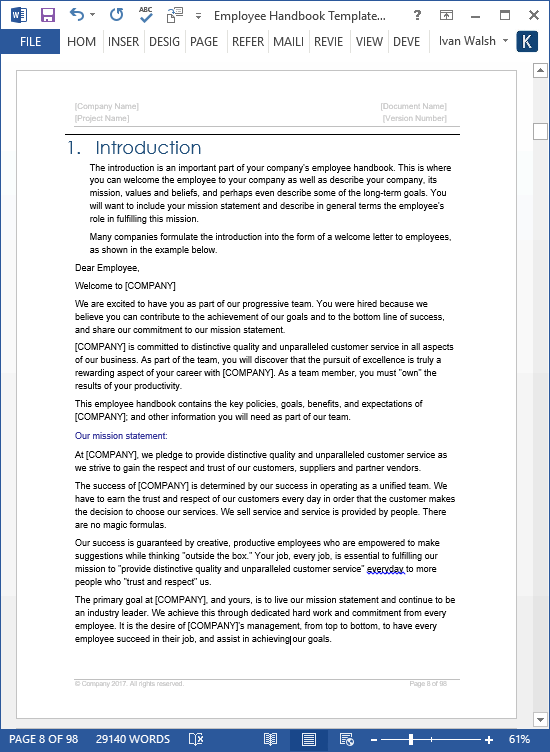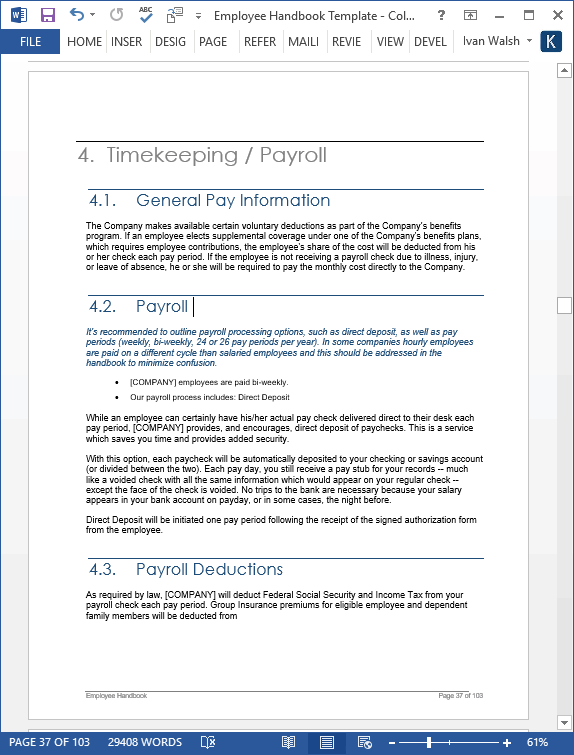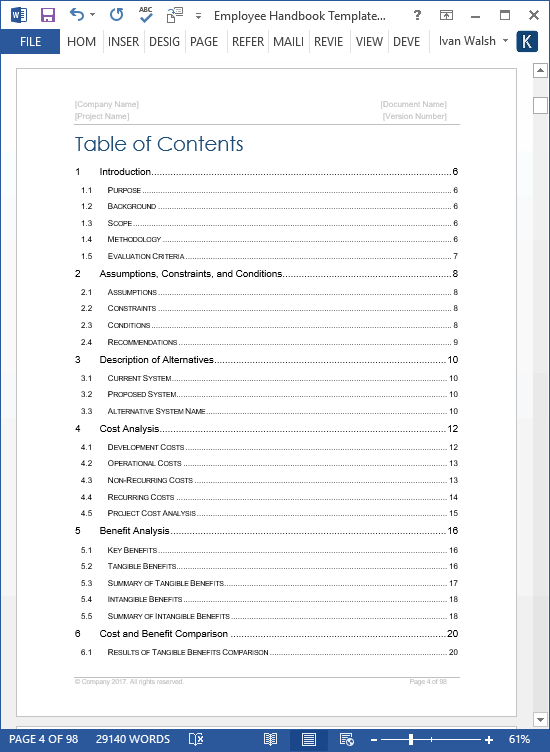Employee Handbook
FAQs about Employee Handbooks
Got a question about how to write an Employee Handbook? Want to know what policies MUST go into an employee manual? Looking for a set of templates to get you started? The Klariti Guide to Employee Handbooks answers the most frequently asked questions in this area. If we missed something, let us know and we’ll update this resources page.
Download this Employee Handbook template with 140 topics in MS Word format to meet your organization’s HR needs.
The MS Word template includes 100 pages of sample material, including sections on Employment Status and Records, Employee Benefit Programs, Timekeeping, Payroll, Anti Discrimination, Harassment, Work Conditions, Leave of Absence, Employee Conduct, Disciplinary Actions, IT Policies, and Health and Safety.
Learn more about this Employee Manual template, including screenshots and sample pages
Are you required to have an employee handbook?
It depends on local legislation. However, an employee handbook provides staff, especially new recruits, with the policies and guidelines they are expected to follow at your company.
In other words, while there are laws requiring employers to notify employees of workplace rights, typically federal or state laws do not mandate that you must have an employee handbook.
What is the purpose of having an employee handbook?
The purpose of an employee handbook is to help employees understand their responsibilities when working at your company. It gathers all of the company policies into a single manual which is frequently used in the induction process when on-boarding a new employee.
An employee handbook describes your company’s procedures. Typically, an employer gives it to an employee on their first day of work. By consulting the handbook, an employee can understand what is expected of them in the workplace, and when dealing with colleagues and clients.
- An employee handbook describes what you, as an employer, can expect from your employees.
- An employee handbook also describes what you, as an employee, can expect from your employer.
From my experience, employee handbooks are fall into two categories:
- An employee handbook written to comply with regulations. ‘We have to had an employee handbook – let’s get something out there.’
- An employee handbook written to help new employees feel comfortable in their new role, to understand the values the company believes in, and to encourage responsibility when interacting with customers.
Why is it important to have an employee handbook?
Create an employee handbook to:
- Resolve disputes before they arise.
- Protect the employer from the potential of litigation
- Protect the employee from misperception (and potential litigation)
- Provide direction with dealing with clients and customers
- Identify employee rights and entitlements
What are the policies for employees?
Employee policies describe how employees should conduct themselves when interacting with colleagues, clients, and customers. This is increasingly important in an age where the employee is the face of the brand, and online where social media interactions with consumers must be professional and courteous at all times.
Who writes the employee handbook?
The HR department typically write the employee handbook. However, it will rely on input from other departments, such as Finance and Marketing to confirm, review, and approve different policies.
What is an employee handbook?
An employee handbook, sometimes also known as an employee manual, staff handbook, or company policy manual, is a manual given to employees by an employer, typically on the first day they start their employment.
It includes information about the company’s culture, policies, and procedures.

Learn more about this Employee Manual template
Is an employee handbook a contract?
No, it is not a contract – unless is specifically says it is a contract.
However, the employee might be asked to sign that they have read and understand the handbook.

In the event of a legal dispute, this may be used to prove that the employee was made aware of the employer’s policy in the regards to the policy in question.
Why is it important to have policies and procedures in the workplace?
Policies establish and help reinforce the standards expected of employees in the workplace. The employee handbook provides direction on how an employer expects employees to behave.
It also confirms the worker’s rights, both statutory (e.g. national holidays) and internal company policies, such as those related to harassment, bullying, discrimination and so forth.
Policies encourage employees to be more accountable when dealing with issues related to health and safety, legal liabilities, regulatory requirements, and other issues with serious consequences.
What is the purpose of policies and procedures in the workplace?
Workplace policies define the boundaries for acceptable behavior and provide guidelines for best practices in work situations.
Policies provide direction to employees on how you expect them to act, both internally and externally.
How do you implement a new workplace policy?
Follow these steps to implement a new employer policy.
- Identify the need for a Policy.
- Create the content
- Obtain support from stakeholders
- Communicate with your employees
- Maintain the policies
How do you write a HR procedure?
Follow these steps to write a HR procedure:
- Use Plain English writing guidelines
- Define your typical reader.
- Use the active voice. E.g. John read the book, not The book was read by John
- Use lists to itemize points.
- Avoid jargon and slang.
What is a performance review?
An annual performance review is a scheduled assessment of an employee’s performance for the past 12 months.
During the annual performance review, the employee will be encouraged to demonstrate how they achieved their goals and objectives over the course of the year. Finally, they will work with their manager to agree goals for the following 12 months.
Why it is important to follow employee policies?
An employee manual provide a roadmap for daily operations. It ensures employees comply with laws and regulations, provides guidance for decision-making, and streamlines processes.
What is the purpose of company HR policies?
HR policies are designed to help employees understand their employer’s values, and provide direction on the correct way to interact with customers, for example, on social media.
Why is it important for schools to have policies and procedures?
Policies help schools establish rules, expectations, and accountability for learning and safety. Without these, schools would lack the structure required to support student educational needs.
What is the difference between a policy and procedure?
A policy provides direction in an organization.
A procedure is a series of steps to be followed to accomplish a specific task.
Does Your Small Business Really Needs an Employee Handbook?
A legally sound, well-crafted employee handbook can potentially save a company tens of thousands of dollars in legal costs while serving to relieve administrative confusion by clarifying key company policies.
Does every business need an Employee Handbook?
No always, but it’s recommended.
An employee handbook (or employee manual or staff handbook) details guidelines, expectations and procedures of a business or company to its employees. Employee Handbooks are given to employees on one of the first days of his/her job, in order to acquaint them with their new company and its policies.
How do I Write My First Employee Manual?
Start with a MS Word document and include all the rules and regulations of your company. Then progress to the steps that are required to create your products or provide your services. You will be surprised how much it really helps your company and enables you to have a hands free control over your company.
Is an Employee Manual a Rule Book?
An employee handbook should give more information than just set out a list of rules. It gives management the opportunity to communicate the company’s mission and culture together with setting expectations.
Do your employees know the ground rules?
The Employee Handbook, also called employee manual, sets out in detail the guidelines that govern procedures and expectations of the company from its employees. Whenever a new employee joins a company, the normal practice followed is to provide the employee with a handbook to acquaint them with the new company and its prevailing policies.
How to Write Employee Handbooks Staff Want to Read
Imagine you’re writing an Employee Handbook for the first time. And you wanted others to enjoy reading it. What would you do?
- Share values not rules – Values are positive. Rules are (perceived as) negative. Open the document with an outline of what the company holds dear. What values (not buzzwords) were the driving force behind the company when it was formed? Use these values as themes around which you write the document.
- Include Stories – You can call these anecdotes if you want but it’s something others can relate to. Share a story about WHY you have these values – it should involve a customer/employee interaction. By doing this, you can introduce the Employee Handbook’s principles more elegantly. Instead of forcing the reader to ‘understand’.
- Employee Input – Approach employees personally and ask them to share something that makes them enjoy working at the company. It doesn’t have to be ‘epic’, just something that others can relate to.
What should the Employee Handbooks Table of Contents include?
While it often varies from business to business, specific areas that an employee handbook may address include:
- Welcome statement: briefly describe the company’s history, reasons for its success; how the employee can contribute to future successes. Include a mission statement, or a statement about a business’ goals and objectives.
- Definitions – define full- and part-time employment, and benefits each classification receives.
- Benefits – provide information about employee pay and benefits (such as vacation and insurance). Usually, new employees are awarded some benefits, plus additional rewards (such as enrollment in a 401K retirement account program, additional vacation and pay raises) after having worked for a company for a certain period of time.
- Expectations about conduct and discipline policies. These sections include conduct policies for such areas as sexual harassment, alcohol and drug use, and attendance; plus, grounds for dismissal and due process.
- Guidelines for employee performance reviews (such as how and when they are conducted).
- Policies for promotion or demotion to a certain position.
- Rules concerning mail; use of the telephone, company equipment, Internet and e-mail; and employee use of motor vehicles for job assignments.
- Emergencies – procedures for on-the-job accidents, such as those that result in injury.
- Termination – how an employee may voluntarily terminate his job (through retirement or resignation), and exit interviews.
- Confidential – a requirement that employees keep certain business information confidential. This area usually includes information about releasing employee records and information, as well as who may retrieve and inspect the information.

Learn more about this Employee Manual template
Download MS Word Employee Handbook
Does your business needs an Employee Handbook? Download this MS Word employee handbook with free checklists and samples.
Use this template to create a user’s manual or employee handbook. This template contains a title page, copyright page, table of contents, chapter pages, and an index.
Download this Employee Handbook template with 140 topics in MS Word format to meet your organization’s HR needs.
The MS Word template includes 100 pages of sample material, including sections on Employment Status and Records, Employee Benefit Programs, Timekeeping, Payroll, Anti Discrimination, Harassment, Work Conditions, Leave of Absence, Employee Conduct, Disciplinary Actions, IT Policies, and Health and Safety.
Learn more about this Employee Manual template
Download Apple Pages Employee Handbook Template
Download this Apple iWork Pages/Numbers employee handbook with free checklists and samples.

